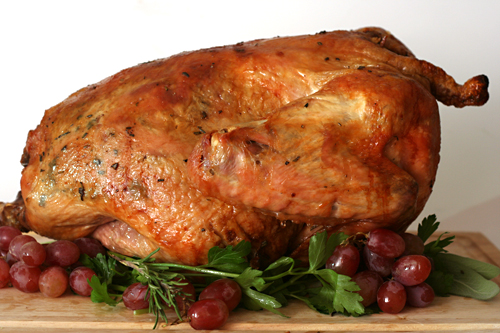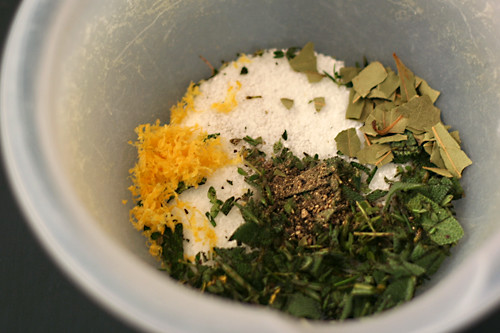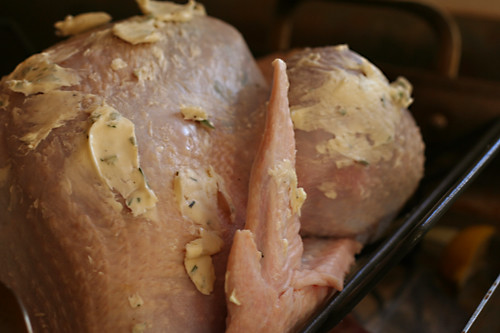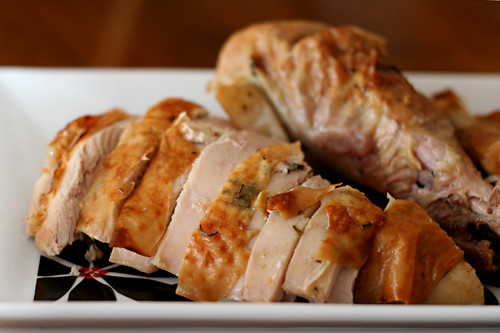I don’t like brining turkey. The first time I tried it, I disinfected a cooler, carefully monitored the ice quantity throughout the soaking period, then disinfected the cooler again after removing the turkey. The second time, I stuck the turkey and brine in a stockpot, but couldn’t quite fit the lid on the pot, plus there was no way I could fit that in my fridge, so I stuck it outside overnight and hoped it was cold enough out there to prevent my turkey from turning into bacteria food. Brining turkey sucks.
Salting turkey isn’t a picnic, but it’s a heck of a lot more straightforward than brining. Just mix up some salt and herbs and sprinkle it inside the turkey’s cavities, over the skin, and under the skin. The salt draws moisture out of the turkey at first, where the liquid mixes with the salt and then flows back into the turkey, now with flavor. While you’re not actually adding moisture like you are with brining, you’re adding flavor and helping the turkey hold onto its natural moisture. And you don’t have to disinfect a cooler or buy a separate fridge.
And, more importantly, this was the best turkey I’ve ever eaten. It wasn’t bloated like brined turkey can be, but it was juicy throughout. It also had crisper skin than brined birds do. You can’t argue with a method that is not only easier, but produces even better results.
Two years ago: Buttermilk Scones
Three year ago: Brown Sugar Apple Cheesecake
Printer Friendly Recipe
Salted Roast Turkey with Herbs (adapted from Bon Appétit via epicurious and from Cook’s Illustrated’s Roast Salted Turkey)
Cook’s Illustrated explains that there are two main brands of kosher salt; Morton’s is denser than Diamond. Use the larger amount of salt called for in the recipe if you’re using Diamond Crystal; if you’re using Morton’s, use only 4 tablespoons of salt.
Don’t salt a kosher or self-basting turkey (like a frozen Butterball)! Those are already salted and will end up way too salty if you add any additional salt.
8-12 servings
Herbed Salt:
6 tablespoons coarse kosher salt (4 tablespoons if finer-grained kosher salt)
1 tablespoon fresh rosemary, minced
1 tablespoon fresh sage, minced
1 tablespoon fresh thyme leaves
3 small bay leaves, coarsely torn
1 teaspoon black peppercorns, crushed
1 teaspoon finely grated lemon peel
Turkey:
1 14- to 16-pound turkey (neck, heart, and gizzard removed)
1 large onion, coarsely chopped
1 large celery stalk, coarsely chopped
1 whole lemon, coarsely chopped
1 tablespoon fresh rosemary
1 tablespoon fresh sage
1 tablespoon fresh thyme
½ cup (1 stick) unsalted butter, at room temperature
2 cups (or more) unsalted chicken broth or Golden Turkey Stock
1. For the herbed salt: Combine the salt, herbs, and pepper. (Can be made 1 week ahead; cover and refrigerate.) Stir in the lemon peel just before using.
2. For the turkey: Rinse the turkey inside and out (do not pat dry). Pull any fat pads from the main cavity and the neck cavity. Rub about half of the salt mixture over the outside of the turkey. Rub half of the remaining salt mixture in the cavities. Use your fingers to loosen the skin over the breasts and thighs. Rub the last portion of herbed salt under the skin. Transfer the turkey to a large bowl or plate, cover tightly, and refrigerate at least 24 hours or up to 48 hours.
3. Adjust an oven rack to the lowest position; heat the oven to 425 degrees. Rinse the turkey inside and out; pat very dry. Combine the chopped onion, celery, lemon, and herbs; divide the onion mixture between the main and neck cavities. Fold the neck skin under and secure with a skewer. Use kitchen twine to loosely tie the legs together. Place the turkey, breast-side down, on a roasting rack set in a large roasting pan. Spread the butter all over the turkey. Pour two cups of stock or broth into the bottom of the roasting pan.
4. Roast the turkey for 45 minutes. Remove the turkey from the oven; lower the oven temperature to 325 degrees. Using wads of paper towels, turn the turkey breast-side up. Continue to roast until the thickest part of the thigh registers 165 to 170 degrees, 1½ to 2 hours longer.
5. Transfer the turkey, still on the roasting rack, to a rimmed baking sheet. Tent loosely with foil and let rest 30 to 45 minutes before carving and serving.










Totally saving this for whenever I get around to making a turkey! My mom is in charge of that this year so I’m off the hook. I love this method and agree – way easier than brining. Brining always sounded like such a hassle. Thanks for the recipe 🙂
One thing you don’t mention and the link to the original recipe doesn’t mention is do you use a fresh turkey that has not had anything added to it or can you use one that has been previously frozen, for example a Butterball turkey?
Julie – Good point. I’ll update the recipe to include that information.
Wow, the best turkey you’ve ever tasted. Sounds tempting. We brine our turkey using one of those huge Ziplock bags that they have for putting sweaters under your bed. Once the turkey and brining mixture was sealed in the bag, we just threw it in the fridge. Easy peasy. But again, I go back to you saying this was the best turkey you’ve ever had. Might have to try it this year…
HI. I have bookmarked this recipe for my Thanksgiving turkey this year. I am very excited to make it this way. I do have one question though, the herbed salt is used to flavor the turkey, why do you rinse away all the wonderful flavors after so many hours of ensuring that it gets well absorbed???
Thanks,
Dalia
Dalia – Good question. It particularly seems strange when you want to keep the skin dry so it gets crisp in the oven, doesn’t it? However, all the sodium and flavor that’s going to be absorbed by the turkey has been absorbed and is at that point, inside of the turkey. Any extra salt on the outside of the turkey will make the drippings, and therefore the gravy, too salty.
Jen – The two times I roasted a brined turkey, once using a Cook’s Illustrated recipe and once using Alton Brown’s recipe, I was disappointed and wondered what all the fuss was about. With this salted turkey, there was no doubt that this was something special.
Wow that is the most amazing turkey I’ve ever seen.
I usually brine my Turkey. I use Ricardo’s recipe and it is always a success. I never tried this salted turkey but that looks really good.
Bridget always teases me about not remembering what I ate for lunch, let alone last year for Thanksgiving. And honestly, I don’t remember at all what the brined turkeys tasted like. But I DO remember her disinfecting the cooler which was actually pretty funny. I also remember this salted turkey. It was exceptionally good. It was really moist (but not soggy) and perfectly salty (not too much). I’d ask her to make it again but usually when I ask her for repeats I get that I’ve-already-been-there-done-that look. Which is always fine, because whatever new thing she makes is always really good too.
You had me at salted herb, but then you really had me at crispier skin. I am going to try this method this year – I love it! I have brined other meats and like it, but I agree brining a turkey is too much work….especially if this method gives you a lot of the same outcomes.
I was planning on brining my turkey, but now that t-day has been bumped up 2 weeks I don’t think I have time to get it all together plus I certainly don’t have the fridge space and I live in San Diego so keeping it outside would be a BAD idea! Anyway, I’m sold on this turkey, you haven’t let me down yet. I’ll come back on Saturday and let you know how it goes!
Thank you for sharing this recipe! Despite the fact that my cheap thermometer made me over-cook the turkey, it was still awesome. I think I lost some of the overall juiciness, but it still wasn’t dry and the flavor was perfect (the drippings were the best!). I know for 100% certain that the digital thermometer is the way to go for next time.Thanks, this is a keeper!
Hi Bridget,
I’m excited to try this recipe this week! One question: was it easy to flip the turkey? (I almost typed bird, then realized that “flip the bird” has a totally different meaning.) I’ve had trouble flipping a 4 lb. chicken. Any tips?
Suzanne – It isn’t so bad so long as a leg or a wing doesn’t get caught in the roasting rack. 🙂 I use a dry paper towel in each hand as a pot holder (that can get dirty and be thrown away). It isn’t my favorite part of roasting a turkey, but I’ve always managed to get it done!
Can you do do this technique with turkey breast as well?
I did a trial run, and it was the best turkey I ever made! So much easier (and less spongy) than brining. I did let it sit for 3 days in frig, and then soaked it for about 20 minutes before roasting to make sure I got rid of the salt before proceeding. Great recipe!!
Hi Bridget,
Just wanted to say I’ve been using this recipe every year since my comment above. The turkey gets raves every year! I butcher the turkey (breast/wing, leg/thigh) before roasting and then all the surfaces get evenly brown. Thanks for such a fantastic recipe!